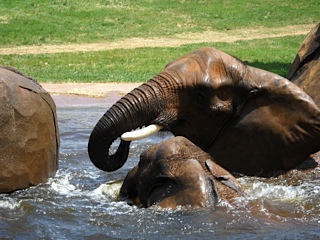You can’t repeat a visit to the North Carolina Zoo. Oh, you can go back again and again, but you can’t have the same visit twice. The animals always see to that.
 |
| Follow Link for More Frolicking African Elephants |
| N'kosi, Silverback Gorilla, June 23, 2013 |
On my next visit to the zoo in February 2014, I expected to shed more tears for Nik during the gorilla feeding, but still eagerly anticipated seeing Nik's offspring. While Nik will always be my first gorilla-love, his two sons, half-brothers Apollo and Bomassa, born in late summer 2012, are quite adorable.
If you'd like a look at this gorilla family through a professional photographer's eyes, check out the beautiful work of this Chapel Hill nature photographer who has been documenting Apollo and Bomassa, almost from birth.
 |
White Rhino Luncheon — Feb. 9, 2014 |
One venue that is always entertaining is the Kitera Forest Chimpanzee Habitat, home to two groups of chimps; the groups include matriarchs well into their 40s, as well as really rowdy youngsters less than 2. This visit we were treated to a dance when this teenage male chimp was "inspired" by a young man on the other side of the glass. (Tired feet alert: Although you veer off a main path down a hill to get here, the enclosed viewing area offers nice seating on elevated platforms so you can rest while the chimps entertain you.)
You May Also Like To Know:
WHEN TO GO: Weather permitting, the zoo is open every day except Christmas. My significant other and I frequently use the weather forecast to determine when we’ll make an impromptu 90-minute drive from Raleigh to the zoo in Asheboro, about 35 miles south of Greensboro, N.C. (NC Zoo on Google Maps). We usually go on non-holiday weekends in the spring or fall, when the forecasted high for the day is 80° or less. That said, a nice sunny break in winter weather can bring a great day, with much smaller than usual crowds, like we had on February 9.
ONCE YOU GET THERE: By now, it may be obvious that I pretend I’m on an African safari at the zoo, waiting for a beast to surprise me around the next bend. The zoo has two main "continents," Africa and North America; all the animals above are in Africa. Each section has a parking lot, ticket booth and entrance, so you may start your day in either section. Trams run between the continents inside the zoo, and also between the parking lots. With more than 5 miles of hilly walking paths in the zoo, the tram ride can be a nice way to give your feet a rest. My favorite North American venue is the Rocky Coast polar bear and harbor seal exhibit, located close to the North American Tram Stop. When I don't have time to see the full zoo, I concentrate on Africa, but catch the tram at the Junction Tram Stop, located between the two continents, hop off in North America to visit Rocky Coast, then right back on to return to Africa. (Easy peasy when the park’s not crowded; no promises about how quickly you can board a tram when the zoo is jam-packed!)
MEMBERSHIPS: We go to the zoo more often because we maintain an "individual-plus" membership that includes free admission to most of the zoo offerings. The "family level" at $74 for "two adults who live in the same house and their children under 18 years old" is a great value, particularly for large families.
FEEDING TIMES: Some of our most exciting times at the zoo have centered around feedings. Check the notice boards inside the zoo’s entrances for scheduled public feedings and presentations.
WE LOVE THE ZOOKEEPERS: When you see a zoo staffer on the edge of a crowd — ofttimes after a scheduled talk or feeding — engage them. They will tell you things about the animals you may not learn anywhere else. (Sometimes, they resemble grandparents discussing a favorite grandchild.) I know a group of rhinos is called a "crash" and male teenage chimps are the biggest showoffs in their groups only because the zookeepers love talking about their babies. And, although I prefer to believe the majestic silverback gorilla Nik hung out beside me because I was his "Fay Wray," in reality, an enterprising zoo staffer with a great arm precisely pitched those carrots next to the viewing window so everyone could have a closer look.
STAYING UP-TO-DATE: You now know just a little bit about how we, two 50-somethings, enjoy a zoo that is home to more than 200 species, while also doing great research, breeding, education and animal conservation work. The zoo and its supporting 501(c)(3), the North Carolina Zoological Society, do a great job of keeping visitors up-to-date on special events, children's programs, new attractions, park and exhibit weather closures and making the most of a zoo visit on their websites and social media.
The North Carolina Zoo
 |
Animatronics Are A Big Hit at NC Zoo |
– Expanded KidZone play area
– New children’s movie in the 4D theater
– Three baby cougars rescued in Oregon this winter. Kudos to Lighthawk's volunteer pilots for getting them here.
– GIANT animatronic bugs exhibit, now through October. I'm hoping the bugs are a little less aggressive than this dinosaur I encountered in the wildly popular 2012 animatronic exhibit.
